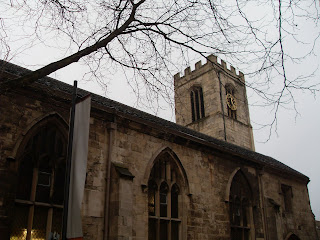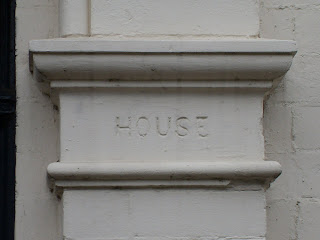In this year [923] King Ragnald won York.
- The Anglo Saxon Chronicle, E manuscript
Beloved men, know what the truth is: this world is in haste, and it approaches the end, and therefore it is ever worse within the world. And so it shall necessarily become very much worse because of the people's sin before the arrival of the Antichrist; and then it will be especially dreadful and terrible throughout the world.
-Sermo Lupi ad Anglos, Archbishop Wulfstan of York (d. 1023)
Archbishop Wulfstan's sermon to the English of c. 1014 is steeped in a repetitive admonitory prose reminiscent to that of Ezekiel in his condemnation of the people of Israel. Wulfstan employed a very dramatic vocabulary in his treatment of the Vikings, a ferocity only rivalled by his attacks on the moral shortcomings of his fellow Englishmen, but the homily was written in a time when much of England was controlled by the Vikings, and when king Aethelred's throne had been usurped by Sweyn Forkbeard. Wulfstan is therefore not solely raging against the Danes, he is also trying to make sense of the series of disasters that recently has struck Britain while navigating in a difficult political terrain.
Despite the ravages of the Vikings in the time of Wulfstan, Sermo Lupi ad Anglos must also be considered in the view of their role as settlers and conquerors, not solely as ravagers. This is particularly pertinent with regards to the town of Eoforwic, which the Danes named Jorvik and we today know as York, where the Danes carved out a capitol for their North-English territories following an invasion led by Ivar the Boneless in 866. However, although the Danes in this manner evolved from Vikings into settlers, they are best remembered as the plunderers they started out as. This is, of course, quite natural since the turmoils did not subsist once the Danes had settled. Not even following the Norwegian Eric Bloodaxe's defeat by the Wessex king Eadred in 954 did the region experience times of peace and calm. Both local rebellions and attacks by Norwegian Vikings served to perpetuate the state of turmoil into the 11th century.
In this year [954] the Northumbrians drove out Eric, and Eadred succeeded to the kingdom of the Northumbrians.
- The Anglo Saxon Chronicle, D manuscript
Although the Norse control of York was relatively short-lived, a certain legacy of their influence has remained. That Earl Siward erected a church in honour of St. Olav in 1055, twenty-four years after his canonisation, speaks of a continuous exchange of impulses between the two spheres.
In this year [1030] King Olaf came back into Norway and the people gathered against him and fought with him, and he was killed there.
- The Anglo Saxon Chronicle, D and E manuscripts
On the more mundane level, there also is the streetnames with the suffix "gate". The word gate, as is the case with the word street, is of Norse origin and is found in several streetnames throughout York. Skeldergate is the street of shieldmakers, Coppergate is the street of cupmakers and Micklegate was the largest (most mickle) street.
York is known for its pork and, as the name suggests, has been so for centuries.
According to some sources this means "what-a-street" and refers to its minuscule size. This is the shortest street of York, although quite possibly the one with the longest name, and was allegedly a place of public whipping in the days when they still practised this form of punishment around these parts.It should, however, be noted that the name itself is from the 15th or 16th century, only the suffix "gate" hints at the Nordic legacy.
In the late 70s excavations unearthed remains from the city's Nordic period and the Jorvik Viking Centre was erected on the site in 1984. The Centre features a reconstructed Viking age village with effigies depicting its inhabitants commencing in their various businesses. I visited the Centre together with a friend of mine, and we took the ride through the village, a tour of sights, sounds (brief exchanges in Old Norse, one of them performed by another friend of mine) and smells in an interesting and sometimes horrid interspersion. The Centre's exhibitions also focussed on the archaeological process, showing a varied and impressive display of items excavated from the site. Here are skeletons (with a medical history), luxury goods, everyday tools and, as they proclaim in a disturbingly childish undertone, the biggest piece of human shit unearthed in Northern Europe.
One of the most interesting aspects of the centre is that they actually illustrate what the ground level was at the time of the Norse settlers.
"Not the first time the Norwegians storm York," someone remarked.
- Ulrikke, Jorge Luis Borges
- Ulrikke, Jorge Luis Borges
(c) Victoria Gunter
There is also a centre called Jorvik DIG where children can unearth treasures themselves. This is situated in an old church.
There is, of course, an annual Viking festival in York, and this seems to be a source of excitement both to tourists and the townspeople. Personally I was a bit lukewarm to the concept, but in the company of some friends from Constantine House I explored parts of the festival. What seemed to me to be the main attraction was the market, where various crafted goods were for sale in the manner of a Viking age marketplace, where the vendors and volunteers walked about in costumes. It was all in all a quite enjoyable and there were several interesting and pretty items, but since it was handicraft it was also quite expensive, at least for a student, which is too bad since I would quite like a shield or a boarhide.
Either he indulges in an anachronism or he really believes Pepsi was invented by the Central Asian tribes.
The market was held in two lots, one in Parliament Street, the other in the Guildhall where the group above issues from and where most of the below pictures are taken.
This was without doubt the single most repulsive thing I ever came across during the festival. I nourish a firm skepticism towards Viking romantics or warfare enthusiasts of any kind, but this is beyond naïveté, being well rooted in the tasteless and disgusting realm of either ignorance or Neo-Nazism. That the vendor was not assailed by the police is beyond my understanding.
Saturday of the week-long festival was the day of the re-enactment. In an allotted space in the Museum Garden, Viking enthusiasts had congregated to play Vikings for a couple of hours while the rain turned the soil into mud and spectators came and went like the occasional glimpses of sun. I almost had to admire their stamina and dedication. It was, however, not very exciting. The reenactors were poorly choreographed and it seemed they didn't really fight a battle as much as a causeless skirmish where everybody fought against everybody.
"At noon,
As the armies met, each mirrored the other;
Neither was outshone. So they flashed and vanished
Neither was outshone. So they flashed and vanished
And all that survived them was the stark ground
Of this pain.
- Funeral Music, Geoffrey Hill
There will be mud.
And there a thousand tombless warriors lie,
Grasping their swords, wild-featured. All are still.
Above them the black ravens wheel and cry.
Grasping their swords, wild-featured. All are still.
Above them the black ravens wheel and cry.
- Hialmar speaks to the Raven, James Elroy Flecker
Aside from the most obvious tourist-traps there are also some other hints of the city's past. There is for instance a St. Olave's street running into Bootham, and on my way to Marygate from the Museum Garden I came across both Jorvik Hotel and St. Olave's House. There is also a Danish kitchen in the city.
(...) foreigners in crowds, Saxons, Flemings, even Danes, visited this country and became Edgar's friends; and their arrival had a very bad effect on its inhabitants, who learnt from the Saxons unalloyed ferocity, from the Flemings a spineless physical effeminacy, and from the Danes a love of drinking, though previously they had been immune from such failings and had maintained their own standards naturally and simply without coveting those of others.
- The History of the Kings of Britain, William of Malmesbury






























































Ingen kommentarer:
Legg inn en kommentar